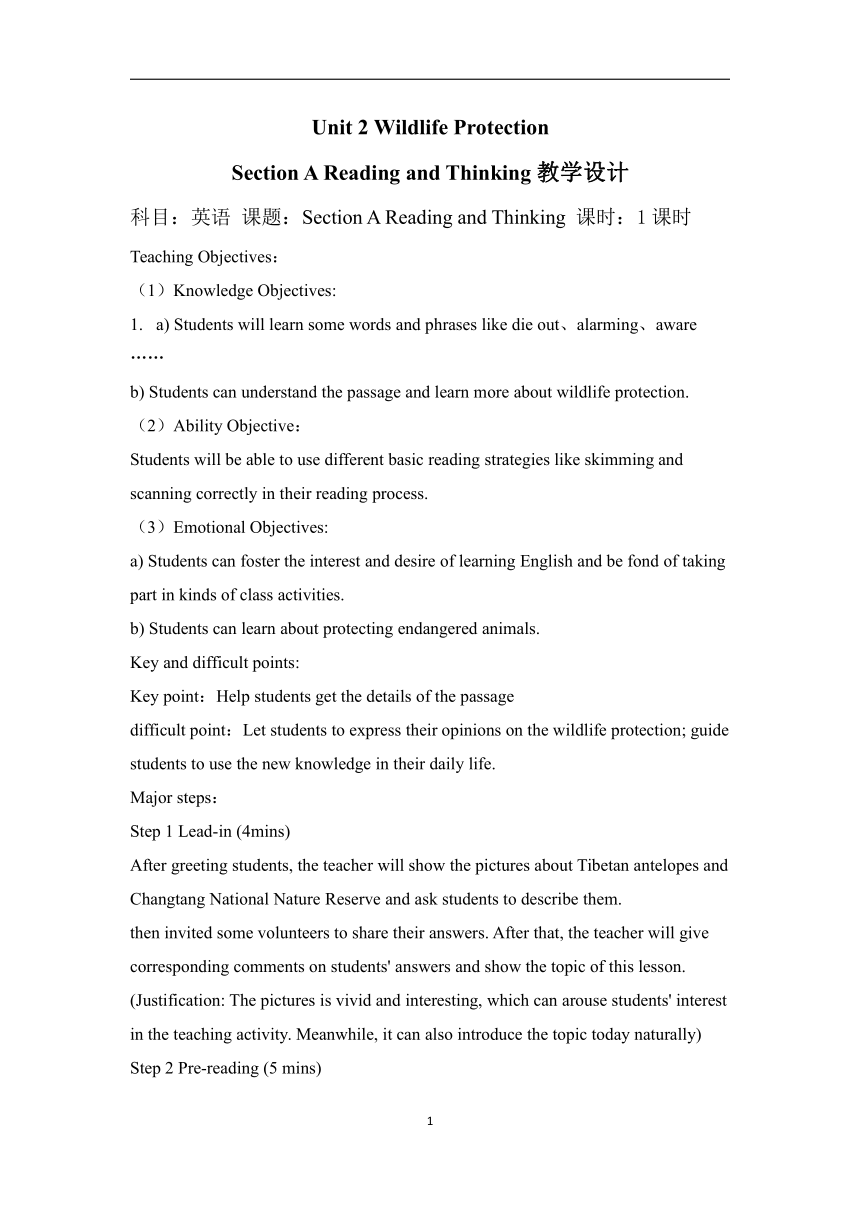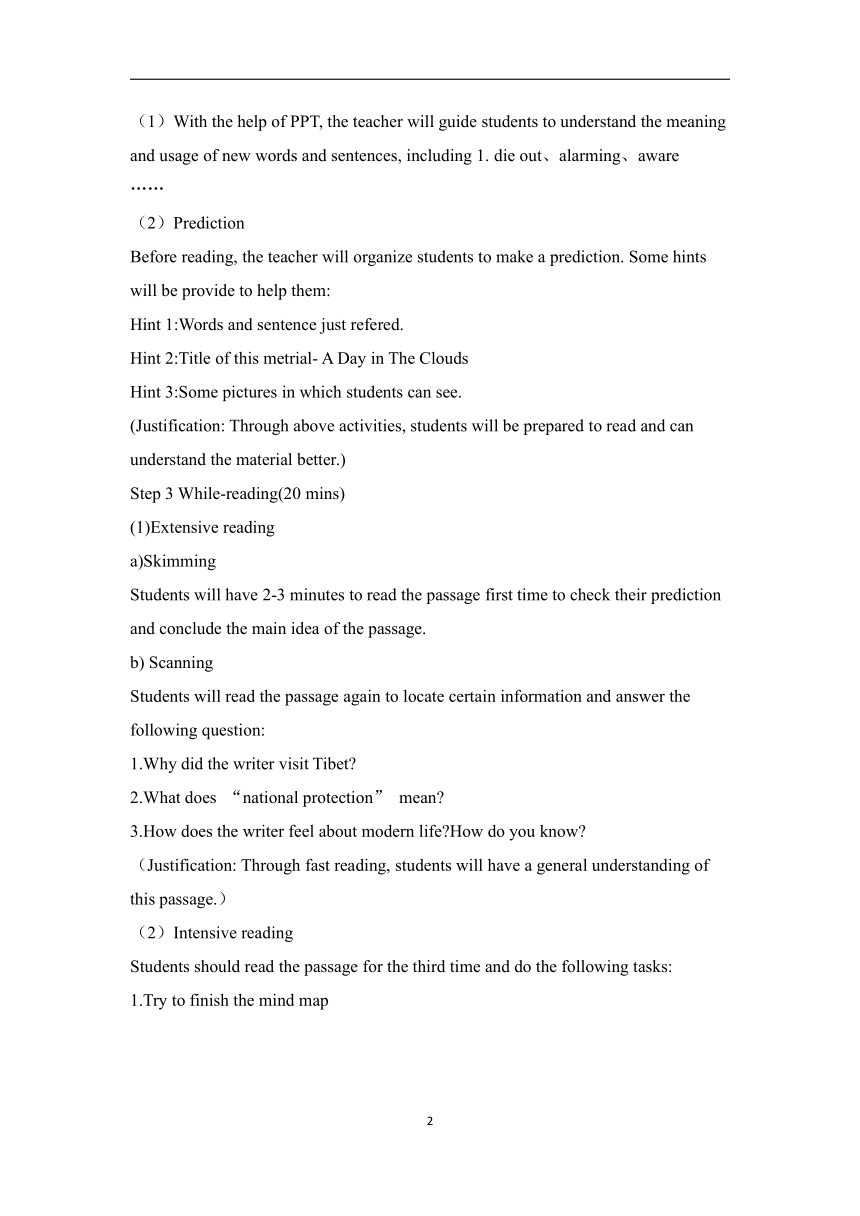人教版(2019)必修第二册Unit 2 Wildlife Protection Section A Reading and Thinking 教案
文档属性
| 名称 | 人教版(2019)必修第二册Unit 2 Wildlife Protection Section A Reading and Thinking 教案 |  | |
| 格式 | docx | ||
| 文件大小 | 145.7KB | ||
| 资源类型 | 教案 | ||
| 版本资源 | 人教版(2019) | ||
| 科目 | 英语 | ||
| 更新时间 | 2022-11-15 14:30:52 | ||
图片预览


文档简介
Unit 2 Wildlife Protection
Section A Reading and Thinking教学设计
科目:英语 课题:Section A Reading and Thinking 课时:1课时
Teaching Objectives:
(1)Knowledge Objectives:
a) Students will learn some words and phrases like die out、alarming、aware
……
b) Students can understand the passage and learn more about wildlife protection.
(2)Ability Objective:
Students will be able to use different basic reading strategies like skimming and scanning correctly in their reading process.
(3)Emotional Objectives:
a) Students can foster the interest and desire of learning English and be fond of taking part in kinds of class activities.
b) Students can learn about protecting endangered animals.
Key and difficult points:
Key point:Help students get the details of the passage
difficult point:Let students to express their opinions on the wildlife protection; guide students to use the new knowledge in their daily life.
Major steps:
Step 1 Lead-in (4mins)
After greeting students, the teacher will show the pictures about Tibetan antelopes and Changtang National Nature Reserve and ask students to describe them.
then invited some volunteers to share their answers. After that, the teacher will give corresponding comments on students' answers and show the topic of this lesson.
(Justification: The pictures is vivid and interesting, which can arouse students' interest in the teaching activity. Meanwhile, it can also introduce the topic today naturally)
Step 2 Pre-reading (5 mins)
(1)With the help of PPT, the teacher will guide students to understand the meaning and usage of new words and sentences, including 1. die out、alarming、aware
……
(2)Prediction
Before reading, the teacher will organize students to make a prediction. Some hints will be provide to help them:
Hint 1:Words and sentence just refered.
Hint 2:Title of this metrial- A Day in The Clouds
Hint 3:Some pictures in which students can see.
(Justification: Through above activities, students will be prepared to read and can understand the material better.)
Step 3 While-reading(20 mins)
(1)Extensive reading
a)Skimming
Students will have 2-3 minutes to read the passage first time to check their prediction and conclude the main idea of the passage.
b) Scanning
Students will read the passage again to locate certain information and answer the following question:
1.Why did the writer visit Tibet
2.What does “national protection” mean
3.How does the writer feel about modern life How do you know
(Justification: Through fast reading, students will have a general understanding of this passage.)
(2)Intensive reading
Students should read the passage for the third time and do the following tasks:
1.Try to finish the mind map
2. Read the sentences below,and decide if each idea is the literal meaning (L) of the text or only implied (I) by the text.
The Tibetan antelope lives high above sea level.
When they first saw the antelopes,they were very far away.
We should not buy goods made from endangered animals.
Human activities are threatening animals and plants.
The Tibetan antelope is not an endangered species now.
(Justification: Through above reading activities, students will not only understand the main idea and details of this reading material, but also improve their reading abilities.)
Step 4 Post-reading (11mins)
Group discussion:
Students need to work in groups to discuss the following question
The writer says that we must change our way of life and learn to live in harmony with nature in order to save our planet.Do you agree What do you think we should do or change
by using the key words/phrases and sentences.
Several minutes will be given. When time's up, several students will be invited to share their answers. Then the teacher will comment on student's perfercece.
(Justification: This task can arouse students' interest and involve the whole class. Also, by group discussion, they will be more confident to share their opinions in public.)
Step 5 Summary and homework (5 mins)
1. Summary
Students should act as an assistant to conclude what they have learned in this class, and then the teacher will make a summary together with students.
(Justification: Reviewing the important knowledge in this lesson can deepen students' impression and form good study habits)
2. Homework
(1)Retell the passage after the class.
(2)Search the internet for more information about wildlife protection and share with others next class.
(Justification: Retelling can help students sort out the course content, and the task of collecting information can help students actively explore more knowledge and information)
作业布置:
2
Section A Reading and Thinking教学设计
科目:英语 课题:Section A Reading and Thinking 课时:1课时
Teaching Objectives:
(1)Knowledge Objectives:
a) Students will learn some words and phrases like die out、alarming、aware
……
b) Students can understand the passage and learn more about wildlife protection.
(2)Ability Objective:
Students will be able to use different basic reading strategies like skimming and scanning correctly in their reading process.
(3)Emotional Objectives:
a) Students can foster the interest and desire of learning English and be fond of taking part in kinds of class activities.
b) Students can learn about protecting endangered animals.
Key and difficult points:
Key point:Help students get the details of the passage
difficult point:Let students to express their opinions on the wildlife protection; guide students to use the new knowledge in their daily life.
Major steps:
Step 1 Lead-in (4mins)
After greeting students, the teacher will show the pictures about Tibetan antelopes and Changtang National Nature Reserve and ask students to describe them.
then invited some volunteers to share their answers. After that, the teacher will give corresponding comments on students' answers and show the topic of this lesson.
(Justification: The pictures is vivid and interesting, which can arouse students' interest in the teaching activity. Meanwhile, it can also introduce the topic today naturally)
Step 2 Pre-reading (5 mins)
(1)With the help of PPT, the teacher will guide students to understand the meaning and usage of new words and sentences, including 1. die out、alarming、aware
……
(2)Prediction
Before reading, the teacher will organize students to make a prediction. Some hints will be provide to help them:
Hint 1:Words and sentence just refered.
Hint 2:Title of this metrial- A Day in The Clouds
Hint 3:Some pictures in which students can see.
(Justification: Through above activities, students will be prepared to read and can understand the material better.)
Step 3 While-reading(20 mins)
(1)Extensive reading
a)Skimming
Students will have 2-3 minutes to read the passage first time to check their prediction and conclude the main idea of the passage.
b) Scanning
Students will read the passage again to locate certain information and answer the following question:
1.Why did the writer visit Tibet
2.What does “national protection” mean
3.How does the writer feel about modern life How do you know
(Justification: Through fast reading, students will have a general understanding of this passage.)
(2)Intensive reading
Students should read the passage for the third time and do the following tasks:
1.Try to finish the mind map
2. Read the sentences below,and decide if each idea is the literal meaning (L) of the text or only implied (I) by the text.
The Tibetan antelope lives high above sea level.
When they first saw the antelopes,they were very far away.
We should not buy goods made from endangered animals.
Human activities are threatening animals and plants.
The Tibetan antelope is not an endangered species now.
(Justification: Through above reading activities, students will not only understand the main idea and details of this reading material, but also improve their reading abilities.)
Step 4 Post-reading (11mins)
Group discussion:
Students need to work in groups to discuss the following question
The writer says that we must change our way of life and learn to live in harmony with nature in order to save our planet.Do you agree What do you think we should do or change
by using the key words/phrases and sentences.
Several minutes will be given. When time's up, several students will be invited to share their answers. Then the teacher will comment on student's perfercece.
(Justification: This task can arouse students' interest and involve the whole class. Also, by group discussion, they will be more confident to share their opinions in public.)
Step 5 Summary and homework (5 mins)
1. Summary
Students should act as an assistant to conclude what they have learned in this class, and then the teacher will make a summary together with students.
(Justification: Reviewing the important knowledge in this lesson can deepen students' impression and form good study habits)
2. Homework
(1)Retell the passage after the class.
(2)Search the internet for more information about wildlife protection and share with others next class.
(Justification: Retelling can help students sort out the course content, and the task of collecting information can help students actively explore more knowledge and information)
作业布置:
2
